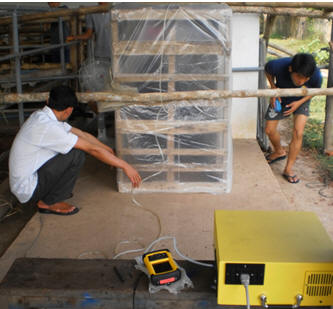Biochar reduces methane emissions and improves growth in Cattle

http://www.lrrd.org/public-lrrd/proofs/lrrd2411/leng24199.htm
In their study in Honduras, the authors carefully mixed rice hull char (made in a TLUD stove) with cassava chips and foliage and fed that to cattle, while doing a careful control, and measuring the health of the cattle as well as their methane emissions. The results are encouraging.
Twelve local “Yellow” cattle with initial live weight ranging from 80 to 100 kg were assigned in a completely randomized block design to a 2*2 factorial arrangement of four treatments with three replications. The factors were: biochar at 0.6% of diet DM or none; and potassium nitrate at 6% of diet DM or urea at 1.83% of diet DM. The basal diet was cassava root chips fed ad libitum and fresh cassava foliage at 1% of LW (DM basis). Sodium sulphate and sodium chloride were added to the diet at the rate of 0.4% and 0.5% in the DM. The trial lasted 98 days following a 21 day adaptation to the diets.
Live weight gain was increased 25% by adding biochar to the diet DM and tended to be decreased when nitrate replaced urea as the source of NPN. DM feed conversion was improved by biochar and by urea replacing nitrate. DM feed intake was not affected by supplementation with biochar nor by the NPN source. Both biochar and nitrate reduced methane production by 22 and 29%, respectively, the effects being additive (41% reduction) for the combination of biochar and nitrate.
Please refer to their study page directly for the detail:
http://www.lrrd.org/public-lrrd/proofs/lrrd2411/leng24199.htm
